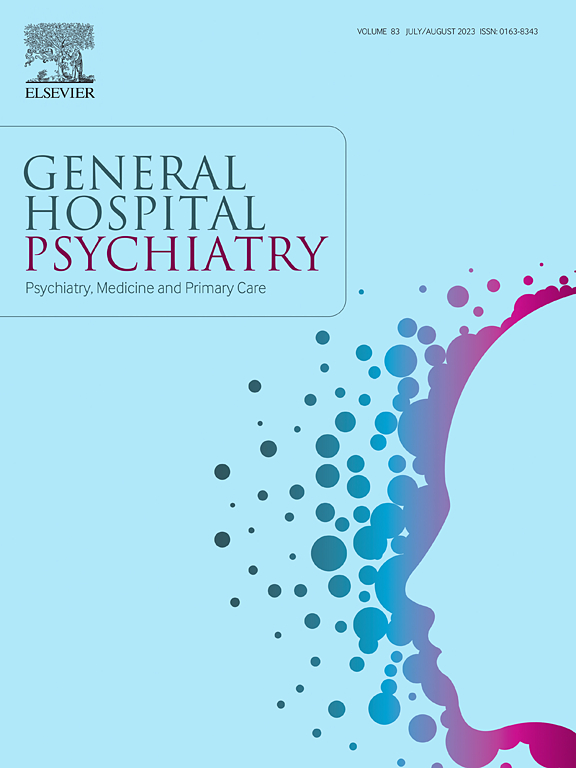Referral to chronic pain management and physiotherapy services in adults with severe mental illness: A matched cohort study
IF 3.7
2区 医学
Q1 PSYCHIATRY
引用次数: 0
Abstract
Introduction
Chronic pain (CP) is common among people with severe mental illness (SMI). It remains unclear whether patients with comorbid CP and SMI receive equivalent pain management referrals compared to those with CP alone. This retrospective cohort study used linked primary and mental healthcare data to address this knowledge gap.
Methods
We identified patients aged ≥18 years with comorbid SMI and CP from secondary mental healthcare records, with the later of either diagnosis serving as the index date. Cases were matched 1:4 by age bands and gender to controls with CP but no SMI diagnosis. Co-primary outcomes were referrals to specialized pain treatment services and musculoskeletal physiotherapy. Cox regression models analyzed associations between SMI status and referral patterns, with sensitivity analyses stratifying follow-up into early (0–3.99 years), medium (4–7.99 years), and late (≥8 years) periods.
Results
The final sample included 1120 patients with CP and SMI and 2681 matched non-SMI controls. SMI diagnosis strongly predicted increased healthcare utilization in adjusted analyses, with significantly higher referral rates to pain treatments (HR = 13.2, 95 % CI 7.8–22.4, p < 0.001) and physiotherapy (HR = 11.5, 95 % CI 9.3–14.4, p < 0.001). The association between SMI and pain treatment referrals was strongest during the early post-diagnosis period (HR = 13.2, 95 % CI 6.6–26.4, p < 0.001).
Conclusion
Contrary to expectations, people with SMI and CP received more pain management referrals compared to matched controls, particularly in the early post-diagnosis period. These findings were restricted to those with a CP diagnosis already, and further research should investigate whether increased referrals translate to improved clinical outcomes.
转介慢性疼痛管理和物理治疗服务的成人严重精神疾病:一项匹配队列研究
慢性疼痛(CP)在重度精神疾病(SMI)患者中很常见。目前尚不清楚,与单纯CP患者相比,合并CP和SMI的患者是否接受了同等的疼痛管理转诊。这项回顾性队列研究使用相关的初级和精神卫生保健数据来解决这一知识差距。方法从二级精神卫生保健记录中确定年龄≥18岁的SMI和CP合并症患者,以两种诊断的较晚日期为指标日期。病例按年龄和性别与有CP但未诊断为重度精神分裂症的对照组1:4匹配。共同主要结局是转诊到专门的疼痛治疗服务和肌肉骨骼物理治疗。Cox回归模型分析了重度精神分裂症状态与转诊模式之间的关系,并通过敏感性分析将随访分为早期(0-3.99年)、中期(4-7.99年)和晚期(≥8年)。结果最终样本包括1120例CP合并重度精神分裂症患者和2681例非重度精神分裂症对照。在调整分析中,重度精神分裂症诊断强烈预测了医疗保健使用率的增加,疼痛治疗的转诊率显著增加(HR = 13.2, 95% CI 7.8-22.4, p <;0.001)和物理治疗(HR = 11.5, 95% CI 9.3-14.4, p <;0.001)。SMI与疼痛治疗转诊之间的相关性在诊断后早期最强(HR = 13.2, 95% CI 6.6-26.4, p <;0.001)。结论与预期相反,与对照组相比,重度精神分裂症患者和CP患者接受了更多的疼痛管理转诊,特别是在诊断后的早期。这些发现仅限于那些已经被诊断为CP的患者,进一步的研究应该调查是否增加转诊转化为改善临床结果。
本文章由计算机程序翻译,如有差异,请以英文原文为准。
求助全文
约1分钟内获得全文
求助全文
来源期刊

General hospital psychiatry
医学-精神病学
CiteScore
9.60
自引率
2.90%
发文量
125
审稿时长
20 days
期刊介绍:
General Hospital Psychiatry explores the many linkages among psychiatry, medicine, and primary care. In emphasizing a biopsychosocial approach to illness and health, the journal provides a forum for professionals with clinical, academic, and research interests in psychiatry''s role in the mainstream of medicine.
 求助内容:
求助内容: 应助结果提醒方式:
应助结果提醒方式:


